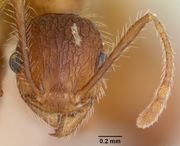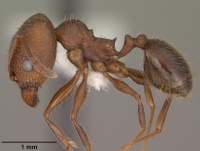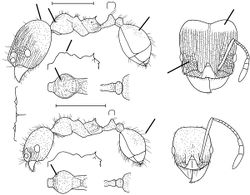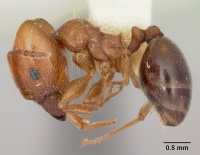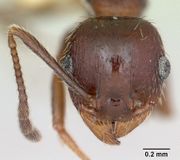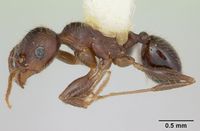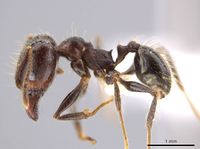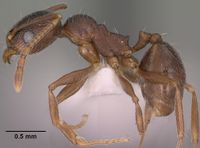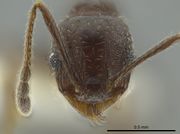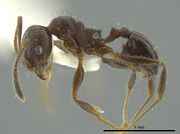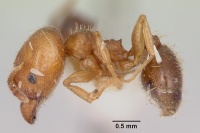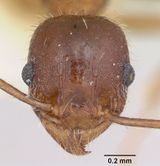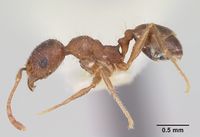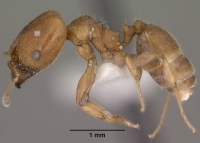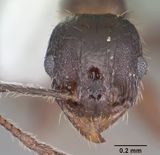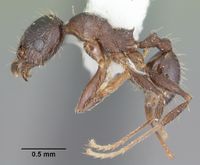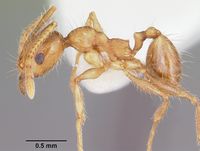Key to Pheidole crassicornis group
This key species of the Pheidole crassicornis group is based on Wilson (2003) as modified by Vazquez-Franco et al. (2024).
This compact assemblage of medium-sized species is an apparent monophyletic offshoot from a common ancestor with the fallax group, or else a derivative phylad within it. It shares the same basic head and body form, as well as the same general pattern of rugoreticulate sculpturing, as members of the fallax group. Its distinguishing features are the flattened basal portion of the antennal scape and consistently broad occiput of the minor worker (a slight deviation in the latter character occurs in Pheidole erethizon and Pheidole guerrerana). All of the known crassicornis-group species are Nearctic, ranging among themselves variously from the southeastern United States to the southern reaches of the Mexican Plateau. (Two Neotropical species, Pheidole claviscapa, placed in the fallax group, and Pheidole vafra, placed in the diligens group, also have broadened scapes but are excluded from the crassicornis group because their minor workers have narrowed occiputs with well-developed posterior nuchal collars. Three other species placed here in the crassicornis, namely erethizon, Pheidole fariasana, guerrerana, and Pheidole spathicornis, may belong phylogenetically in the fallax group, as evidenced by the head shape and sculpture of the major caste. In other words, the basal flattening of the scape may be a trait subject to easy convergence.
1
- Occiput of major and minor rugoreticulate (Texas) (placed in the fallax group group; also keyed out here to ensure identification) . . . . . Pheidole texana
 Pheidole texana, Major |
- Occiput of major and minor smooth, carinulate, or foveolate, not rugoreticulate . . . . . 2
2
return to couplet #1
- Occiput of major cannulate (Colorado, southwestern U.S.) (placed in the fallax group; also keyed out here to ensure identification) . . . . . Pheidole cockerelli
 Pheidole cockerelli, Major |
- Occiput of major smooth or foveolate . . . . . 3
3
return to couplet #2
- Major: parallel longitudinal carinulae covering anterior three-fourths of head capsule, leaving only the occiput bare. Minor: all but posterior quarter of the first gastral tergite shagreened and subopaque (Hidalgo, Mexico) . . . . . Pheidole pinicola
- Major: parallel longitudinal cannulae covering at most the anterior two-thirds of head capsule. Minor: at most only the anterior fringe of the first gastral tergite shagreened, the remainder bare and shiny . . . . . 4
4
return to couplet #3
- First gastral tergite of major in profile devoid of pilosity or nearly so, at most with 1-3 hairs projecting above margin . . . . . 5
- First gastral tergite of major in profile with abundant hairs . . . . . 6
5
return to couplet #4
- Major: in full-face view, profile of occipital lobes subangulate, coming together at midline of head in a deep cleft that is also subangulate (Texas) . . . . . Pheidole bureni
 Pheidole bureni, Major |
- Major: in full-face view, occipital lobes broadly rounded, coming together at midline of head in a rounded median cleft . . . . . 5a
5a
return to couplet #5
- Major: in side view, anapleural sulcus present, strongly printed; promesonotal profile in dorsal oblique view with three convexities (Fig. 11A) . . . . . Pheidole jolalpanensis
- Major: in side view, anapleural sulcus absent or lightly printed; promesonotal profile in dorsal oblique view with 2 convexities (Fig. 11B) . . . . . Pheidole crassicornis
 Pheidole crassicornis, Major |
6
return to couplet #4
- Major: hairs on dorsum of first gastral tergite very long, many exceeding 1.5X the maximum length of the eye . . . . . 7
- Major: hairs on dorsum of first gastral tergite short, at most slightly exceeding the maximum length of the eye . . . . . 11
7
return to couplet #6
- Major: almost all of the sculpturing on the dorsum of the head posterior to the level of the eye and exclusive of the occipital lobes consists of rugoreticulum (southcentral Mexico) . . . . . 8
- Major: almost all of the sculpturing on the dorsum of the head posterior to the level of the eye consists of carinulae . . . . . 9
8
return to couplet #7
- Major: lateral margins of postpetiole seen from above angulate. Minor: head bicolored, yellow and yellowish brown; occiput narrow, with nuchal collar (Guerrero) . . . . . Pheidole guerrerana
 Pheidole guerrerana, Major |
- Major: lateral margins of postpetiole seen from above concolorous reddish yellow; occiput broad, lacking nuchal collar (Morelos) . . . . . Pheidole spathicornis
9
return to couplet #7
- Major: entire head, up to and including occiput, foveolate and opaque (Michoacan, Mexico) . . . . . Pheidole erethizon
- Major: most of posterior half of head of major smooth and shiny . . . . . 10
10
return to couplet #9
- Major: carinulae in middle of dorsum of head extends posteriorly to half the distance from the level of the eye to the level of the occipital border. Minor: dorsal surface of head and pronotum foveolate and opaque (Arizona) . . . . . Pheidole vallicola
 Pheidole vallicola, Major |
- Major: carinulae in middle of dorsum of head extending posteriorly only one-fourth the distance from the level of the eye to the occipital border (Tamaulipas, Mexico) . . . . . Pheidole insipida
 Pheidole insipida, Major |
11
return to couplet #10
- Major: seen in profile, ftrst gastral segment with approximately 10 scattered, medium-length hairs that project above the margin; head light reddish brown, with a large, fuzzy-edged dark brown spot on the vertex (San Luis Potosi, Mexico) . . . . . Pheidole coracina
 Pheidole coracina, Major |
- Major: seen in profile, first gastral segment covered with a dense felt of short to medium hairs projecting above the margin; color variable, with no spot on the vertex . . . . . 12
12
return to couplet #11
- Major: seen from side, waist, and ftrst gastral tergite with hairs that are mostly as long as half the maximum eye length or slightly longer; hairs always present on occiput . . . . . 13
- Major: seen from side, waist, and ftrst gastral tergite with hairs that are mostly shorter than half the maximum eye length or (on waist) absent; hairs present or absent on occiput . . . . . 14
13
return to couplet #12
- Major: occipital comers in full-face view subangulate. Minor: sides of head bare and shiny along their entire length (Texas) . . . . . Pheidole pilosior
 Pheidole pilosior, Major |
- Major: occipital comers in full-face view smoothly rounded, forming semi-circles. Minor: sides of head foveolate and opaque (Missouri to Arizona) . . . . . Pheidole tetra
 Pheidole tetra, Major |
14
return to couplet #12
- Major: hairs projecting beyond dorsal margin of first gastral tergite constitute a mixture of very short and medium-length hairs; no hairs on occiput; rugoreticulum mesad to the eye reaching halfway between eye and anterior margin of head; color medium reddish brown. Minor: sides of head foveolate and opaque (Texas to Arizona) . . . . . Pheidole diversipilosa
 Pheidole diversipilosa, Major |
- Major: hairs projecting beyond dorsal margin of first gastral tergite almost all very short and uniform in length; numerous hairs on occiput; rugoreticulum mesad to the eye reaching at most the level of the anterior margin of the eye (Texas) . . . . . Pheidole porcula
 Pheidole porcula, Major |
References
- Vazquez-Franco, C.M., Castano-Meneses, G., Rios-Casanova, L., Morrone, J.J. 2024. Three new species of Pheidole Westwood, 1839 (Hymenoptera: Formicidae: Myrmicinae: Attini) from central Mexico. Zootaxa 5523(2), 192–210 (doi:10.11646/zootaxa.5523.2.3).
- Wilson, E. O. 2003. Pheidole in the New World: A dominant, hyperdiverse ant genus. Harvard University Press, Cambridge, MA.

